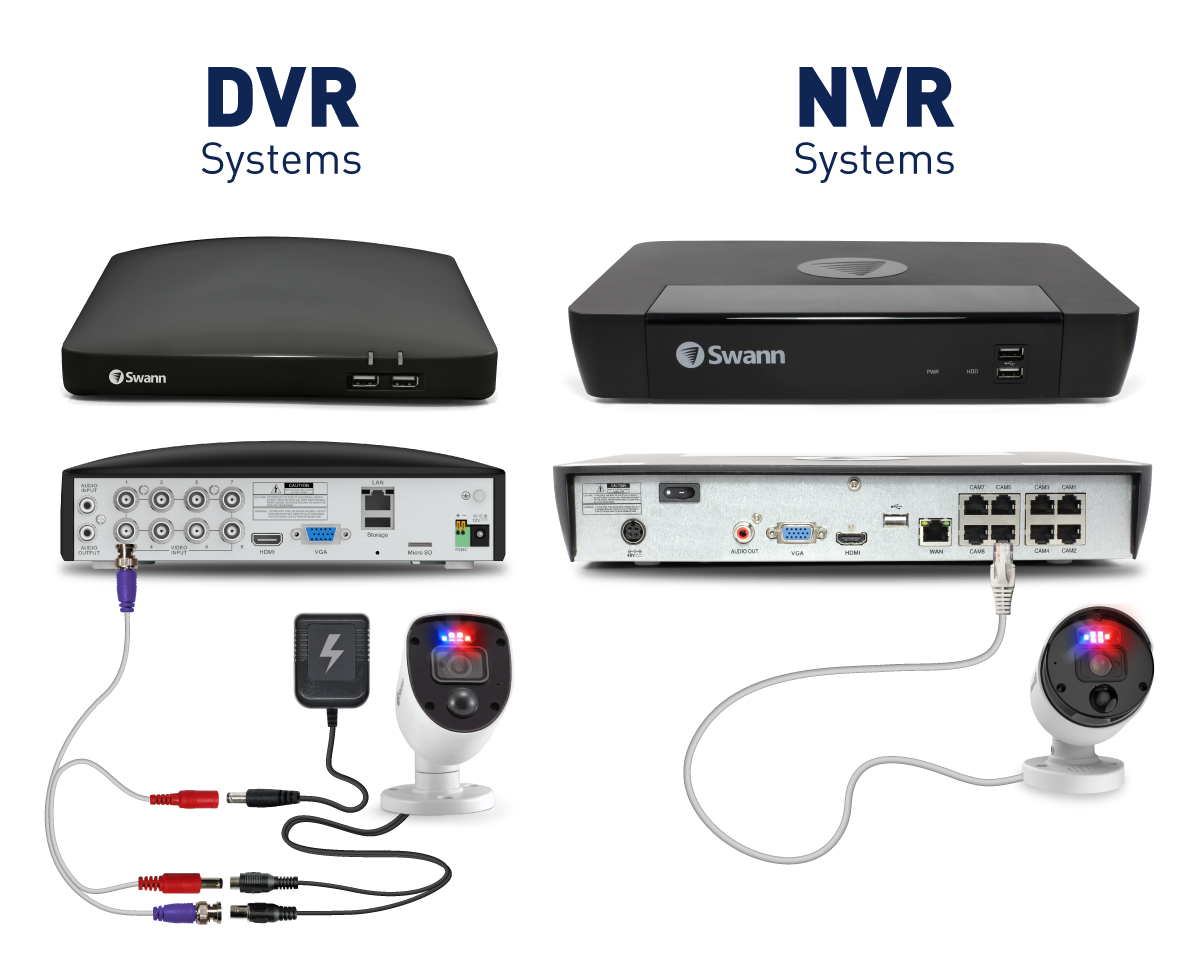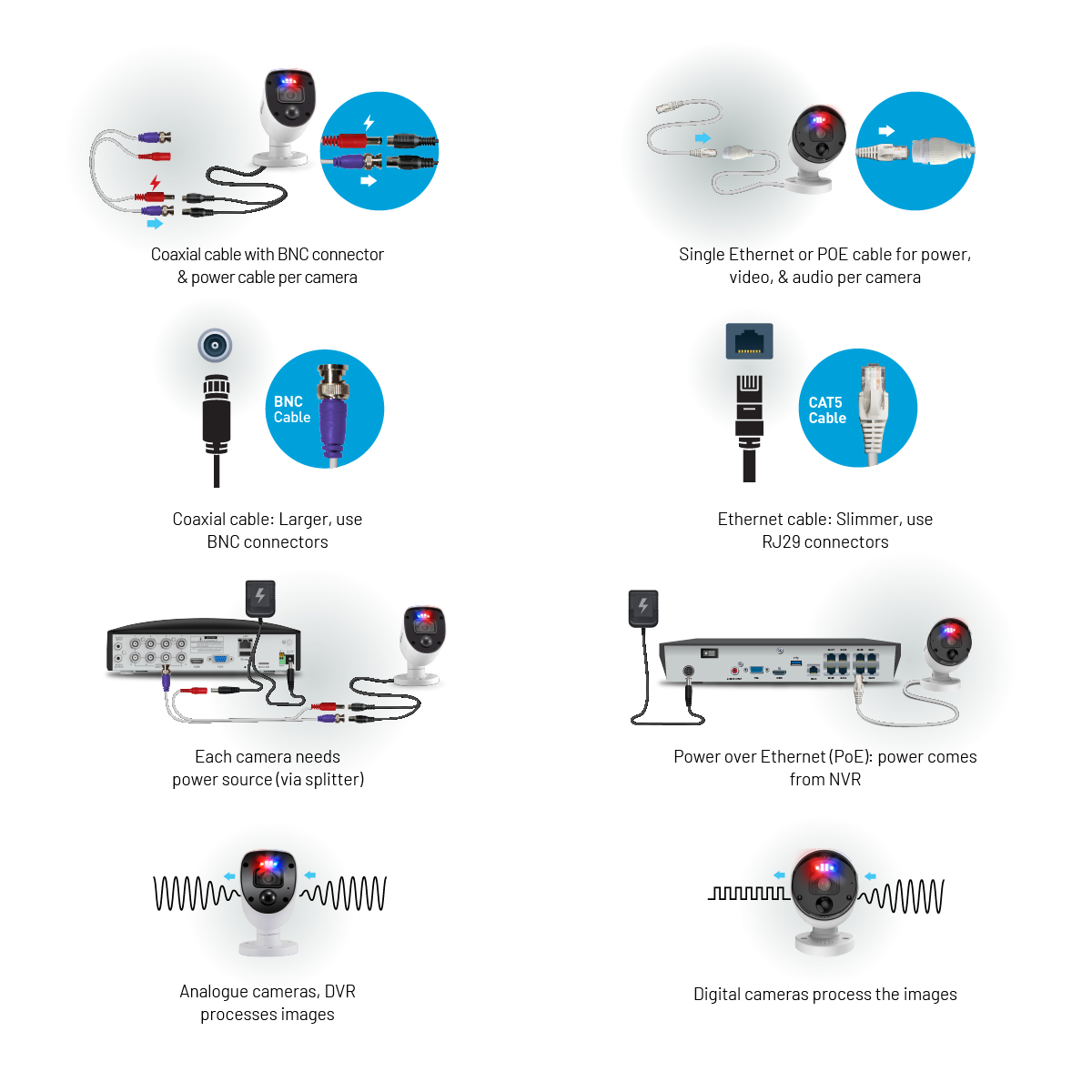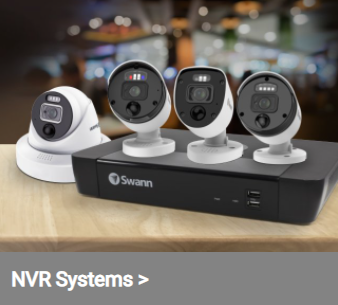Last Updated on 20 September 2023
When shopping for a home or business security system, you’ll need to choose between a DVR or NVR recorder. Whether you’re a novice or a DIY security pro, you may find yourself wondering what the differences are between NVR and DVR systems. While both types of security systems perform the same function, there are key differences between them, such as what type of cameras are used and how they work.
It’s essential to understand the difference between DVR and NVR systems so that you can find a solution to meet your specific needs. In this article, our security experts break down the differences of each system, detailing the pros and cons so that you can make an informed decision.
NVR vs. DVR – Understanding the Basics


When it comes to security systems, the term ‘NVR’ or ‘DVR’ refers to the type of recorder being used. The type of recorder determines a number of factors, including how video is processed and recorded, the types of cameras and connections used, and the flexibility of the system. Let’s explore the basics of NVR and DVR systems before detailing the pros and cons of each.
What is a DVR security system?
DVR stands for Digital Video Recorder. DVR systems use traditional security system technology – analog cameras, coaxial cables, and, of course, a DVR recorder. The analog cameras in DVR systems connect to the recorder through the coaxial cables, transmitting unprocessed video signals. Once the signals reach the recorder, they can be processed and made available for viewing.
What is an NVR security system?
NVR stands for Network Video Recorder. NVRs are a relatively new technology, enabled by advanced IP, or internet protocol, cameras. These digital cameras encode and process video data themselves, then stream it to the NVR recorder for storage and remote viewing. Since NVR systems process video data at the source, not the recorder, they are capable of being wireless. While some NVR systems are made to be wireless, others use Ethernet cables instead.
DVR Security System – Pros & Cons
Advances in analog high definition within the last five years have reduced the gap in resolution between the two systems. You’ll probably notice that DVR based security systems are priced lower than NVR systems. The lower price point is an attractive advantage of DVR systems, but there are some tradeoffs. To explore the advantages and disadvantages of DVR systems, we’ll break down each of the components.
Camera Type – Analog
The cameras used in DVR systems must be analog security cameras, better known as CCTV cameras. There’s no option to mix and match your camera types, as you can with some home security systems, making DVR systems somewhat inflexible.
However, these cameras account for most of the cost savings seen in DVR systems. Without having to process video data themselves, analog cameras are much less complex and more affordable than the digital cameras found in NVR systems.
Cable – Coaxial BNC Cable
The camera connects to the DVR recorder via a coaxial BNC cable. Although the use of coaxial cable may not seem significant, it does have some limitations, detailed below.
As the coaxial cable doesn’t provide power to the camera, there are actually two cables included within one covering – a power and video cable. The cables separate each end to provide the separate functions. As such, you’ll need to install your DVR recorder near a power outlet.
The size and rigidity of coaxial cables can make installation more challenging. The coaxial cable is wider in diameter than Ethernet cables used with NVR systems which can make it more difficult to run cables in tight spaces. Coaxial cables also tend to be more rigid, compounding this problem.
However, if your property has existing coaxial connections for a previous security system, you can use the same cable to connect your new system.
Standard coax DVR systems do not always support audio. For audio capabilities, an RCA connection is needed. But, even with an added RCA connection, only a small number of cameras can support audio due to the limited number of audio input ports on the DVR. To solve this issue, Swann has recently developed audio-over-coax (AoC) technology so an internal microphone in specially-developed DVR cameras and the recorder’s chipset can capture and process audio for you to listen live and be recorded with the video footage. With Swann DVRs they can either have audio via a separate wired RCA microphone or feature audio-over-coax.
The image quality on coaxial cable will begin to degrade after about 300ft/90m, which can limit the ability to which you will extend your security presence outward. Lower quality cable will result in a signal loss at shorter distances.
 Recorder
Recorder
DVR recorders rely on a hardware chipset known as an AD encoder, which is responsible for processing the raw data streaming from the camera into legible video recordings. DVR systems also have different requirements when it comes to the recorder. Specifically, in a DVR system, the user must connect every camera directly to the recorder. In comparison, an NVR system only requires that each camera connects to the same network.
Additionally, in a DVR system, the recorder doesn’t provide power to the cameras. Each camera connection will need a splitter that supplies power to enable cameras to function.
System Flexibility
DVR security systems are less flexible than their NVR counterparts in terms of camera type and mounting options. Whereas NVR based systems can integrate both wired and wireless security cameras, DVR systems can only use wired security cameras. DVR systems also have less flexible mounting solutions, because routing coaxial cable can be more difficult in tight situations and a power outlet is required for each camera.
Image & Audio Quality
As we’ve discussed, in DVR systems the cameras transmit analog video via the coax cable directly to the recorder and images are processed at the recorder level. The analog signal results in a lower quality image compared to NVR systems. Only recent Swann cameras and recorders can transmit an audio signal. Coaxial cables also don’t natively transmit an audio signal, and DVR recorders usually have a limited number of audio input ports.
NVR Security System – Pros & Cons
NVR security camera systems incorporate the newest technology to provide an enhanced, feature-rich security system. Also known as POE security camera systems, NVR based systems are more flexible and complex than DVR systems.
Camera Type – IP Camera
As NVR systems process the video data at the camera rather than on the recorder, the cameras in NVR systems are much more robust than their DVR counterparts. NVR systems use IP cameras which are standalone image capturing devices. IP cameras each have a chipset that is capable of processing the video data which is then transmitted to a recorder. Unlike analog cameras, IP cameras are typically all capable of recording and sending audio as well as video. The more powerful hardware on IP cameras also enables improved smart functionality and video analytics, such as facial recognition.
Cable – Ethernet
Like DVR systems, NVR systems connect the camera to the recorder. However, how they connect the camera to the recorder is entirely different. NVR systems use standard Ethernet cables, such as cat5e and cat6, to transmit data. Professional installers prefer ethernet cables due to the number of advantages compared to coaxial cables:
- Ethernet cable powers the camera using Power over Ethernet (PoE), which means your camera only needs one cable running to capture video, audio, and power the camera, thus eliminating the need for messy splitters like a DVR system.
- Ethernet cable tends to be easier to route and terminate because it is thinner and has a smaller connector allowing for less drilling.
- Ethernet is cheaper than coaxial cable and much more readily available, making cable replacement or system expansion more accessible and affordable. Many modern homes and businesses are being built wired for Ethernet, making installation even easier.
- An added advantage of Ethernet cable is that every camera on the system can transmit audio since Ethernet can send audio data natively.
- Cables do not need to run between every camera and the recorder. They need to be on the same wireless network. Installation is more straightforward and cleaner as multiple cables aren’t required.
- Despite a shorter max Ethernet cable length, 328ft or 100m, network switches can be used to extend total distance without impacting image quality.
Recorder
Unlike a DVR system, the recorder in an NVR system doesn’t process video data. That step is completed at the camera before it is transmitted. NVR recorders are only used for storing and viewing the footage.
System Flexibility
NVR systems are inherently more flexible because security cameras don’t necessarily have to be physically connected directly to the recorder. Instead, IP cameras only have to be on the same network. As such, you could feasibly have cameras all over the world on the same network that connect to your NVR can then be viewed as a comprehensive system.
Image & Audio Quality
As NVR recorders receive a pure digital signal from the cameras, video quality is better than compared to a DVR at the same resolution. In addition, as Ethernet cables carry audio, all cameras with microphones could record audio to the NVR.
In Summary – DVR vs. NVR System
Both NVR and DVR systems record video data and are reliable. Although in the past the video quality of DVR systems lagged behind comparable NVR systems, today this gap is significantly lessened. The difference between DVR and NVR security systems comes down to the cost, how the data is transmitted, and type of cameras involved. NVR systems tend to have better picture quality, as well as easier installation, increased flexibility, and native support for audio on every camera that has a microphone. However, NVR systems also tend to be quite a bit more expensive than comparable DVR systems, which is an important consideration for the budget conscious consumer.
For people looking for a relatively straightforward security system, a DVR system will most likely be sufficient, especially if your property is already wired for a coaxial cable from an existing security system. If you need a top of the line, very flexible solution, an NVR based system may be the best choice. At the end of the day, the deciding factor will be based on the specific security needs of your property.



Comments are closed.